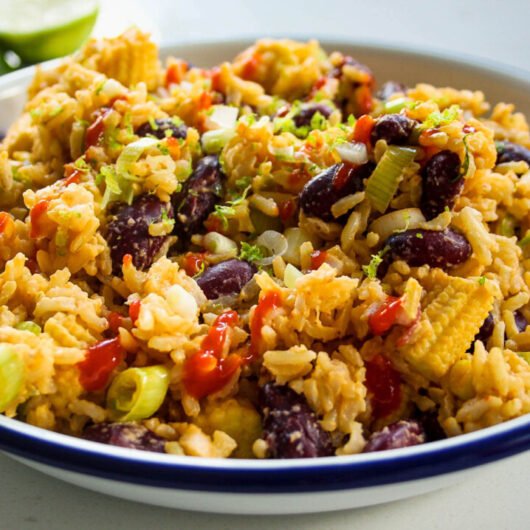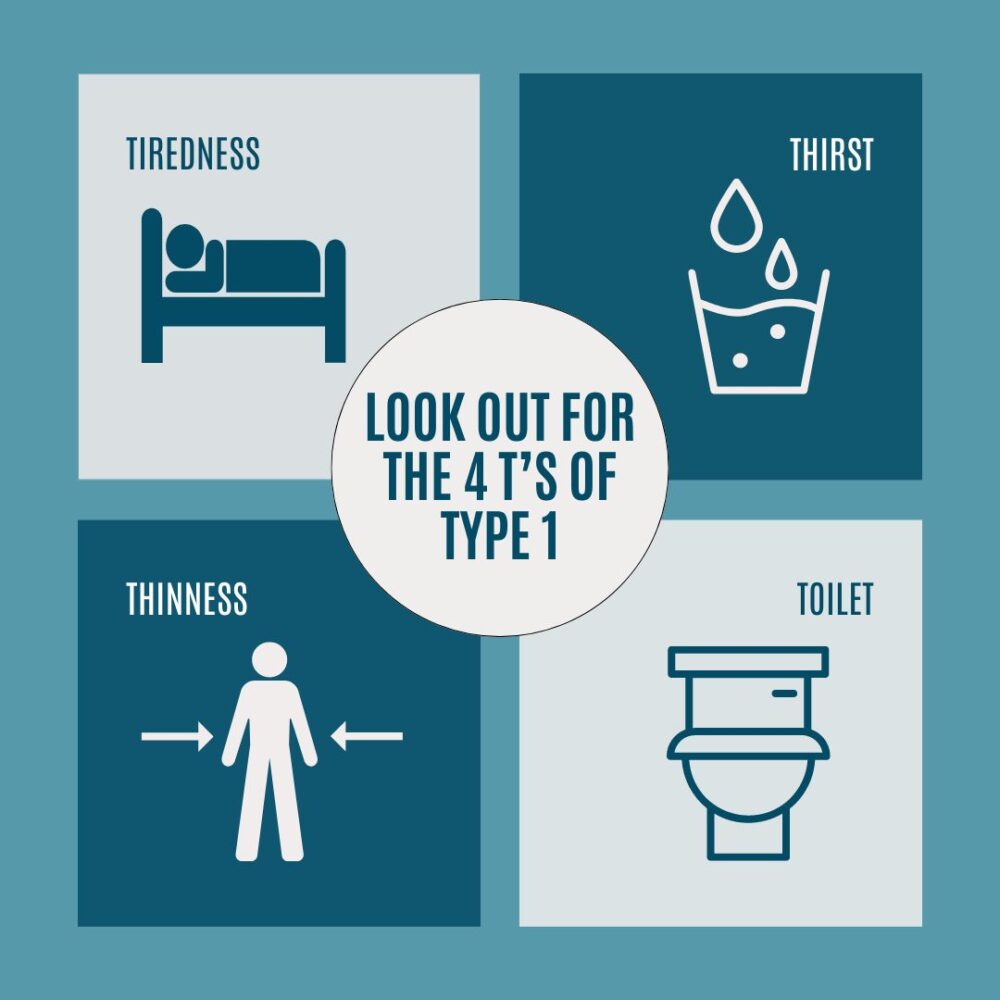This sriracha rice salad is full of wholesome ingredients and deliciously spicy and zesty flavours. It can be served hot or cold; as a tasty side dish, on top of a leafy salad for a lighter lunch or as the perfect dish for your summer BBQ.

Rice is such a super versatile ingredient but sometimes it just needs a little extra flavour and spice to make it a bit more interesting. This sriracha rice salad certainly does that. Full of crunchy vegetables, soft beans and a zesty spicy dressing it makes a great side for so many meals.
Rice really is such a fantastic food to enjoy on its own or as part of your meal. It is full of carbohydrates which are so important for fueling the body. It helps to keep us fuller for longer and gives us energy.
We eat some kind of rice dish regularly every week, but we definitely opt for a wholegrain version over white rice. Using whole foods is a big part of WHK. Not only does it mean that the rice dish is full of its original nutrients and fibre but we have also found that it is much kinder to our daughter’s blood sugar levels. This helps us as part of her overall type 1 diabetes management.
What is Sriracha?
Sriracha, which is actually pronounced suh·raa·chuh, is essentially a hot sauce. It’s made with red chilli peppers, garlic and sugar which gives it its very recognisable spicy, tangy-sweet, garlicky flavour. It’s definitely a lot thicker than a lot of hot sauces, a bit more like ketchup and can be quite spicy depending on the brand you buy.
Fun Fact – Now you may be mistaken in thinking Sriracha is a Mexican sauce but in fact, it is a product of Thailand!
Check the nutrition labels for carb counting as the carbohydrates vary quite a lot between brands.
Is brown rice better than white rice?
So in my opinion yes! I am always looking at ways of increasing our fibre intake and using lower glycaemic Index foods to reduce dramatic blood sugar spikes. Switching to the brown version of carbs is an easy way to do this. Below is a little more detail on the differences between brown and white rice:

Brown Rice
- Is a whole grain carbohydrate and it still contains the bran and the germ along with all of its minerals and nutrients. These most importantly provide the fibre.
- It is a rich source of many nutrients, including manganese, selenium, magnesium, and B vitamins.
- It also has a lower glycemic index than white rice. This means that the carbohydrates enter the bloodstream more slowly, reducing the possibility of rapidly increasing blood sugars after eating.
Choosing lower GI alternatives can really benefit your overall diabetes management! Why not check out my blog The benefits of a whole food diet and diabetes to read more about this.
White Rice
- This is the refined version of the grain, stripped of the bran and germ.
- The processing makes the rice softer, and quicker to cook.
- It has a high Glycaemic Index
- White rice can be a good option however for those that need to avoid fibrous foods.
Whilst brown and white rice are both high in countable carbs and both will cause blood sugar levels to rise, we have certainly found that levels remain much steadier on wholegrain versions over the refined counterparts. I now use wholegrain basmati rice in all my meals because it has the lowest GI of all the rice types and is also the quickest of the brown rices to cook. (approx 25mins)
What you will need for this sriracha rice salad

- Brown Basmati Rice
- Brown rice is a rich source of dietary fibre, which is so essential for our overall health
- It has high levels of magnesium
- Vegetable or Umami stock cube
- These add a subtle umami flavour to the rice
- I like the Kallo Organic Umami Stock Cubes which are available in lots of UK supermarkets
- Spring Onions
- Or also known as scallions
- These are young onions that have a slightly subtler flavour, so less overpowering
- Kidney Beans
- A delicious legume that is a great source of plant-based protein.
- They’re also rich in healthy fibres, which again works to moderate blood sugar levels
- Baby Corn
- Adds a wonderful crunchy texture to this salad
- Rich in Vitamin A, C and iron
- Red pepper
- An excellent source of vitamins A and C
- Adds a natural sweetness and crunch
- Lime
- Adds a zingy tartness which lifts the spiciness of the sriracha
- It also gives you an extra hit of vitamin C
- Tahini
- A paste made from toasted, ground sesame seeds that have a light slightly nutty flavour
- Is brilliant in sauces and dressings to thicken them up.
- Plus it is brilliantly nutritious
- Sriracha sauce
- A delicious Thai hot sauce
- Check the nutrition label for carb counting as the carbohydrates vary quite a lot between brands.
How to make Sriracha rice salad
This is a really simple salad to bring together. The longest part is cooking the rice! But once that is done you can have a delicious side or main meal ready in under 10 minutes.
First, you need to cook your rice. I use double the amount of cold water to rice. This allows the rice to completely absorb the liquid and added flavouring if used.
When the water is boiling add an umami or vegetable stock cube to the water so that the extra flavour can absorb into the grains.
Next make the dressing by simply mixing the sriracha sauce, tahini, 1 of the limes juice and zest in a bowl. You may need to add a couple of tablespoons of water to loosen the dressing.
Once the rice is cooked it’s time to make the salad. In a large frying pan or wok quickly fry the spring onions, baby corn and red pepper for a couple of minutes. Then add the drained kidney beans, rice and dressing and combine well. Season with salt and pepper to taste and gently heat everything through for another couple of minutes.
If you want to enjoy this rice salad hot then serve immediately or if you want it cold then simply transfer to a large bowl, leave to cool for an hour and then cover and store in your fridge until you are ready to enjoy it
Serve with a little extra sriracha sauce, lime juice and zest.

Serving suggestions for the Sriracha rice salad
This salad is wonderful served either hot or cold. It is a great gluten-free and vegan friendly side that can also be enjoyed as a main meal on its own. But here are some further suggestions on how you can serve and savour this sriracha rice salad.
- As a side with grilled salmon or chicken basted in the same sriracha sauce dressing used in the rice salad (pictured below)
- Add some marinated tofu when you are stir-frying the vegetables
- Add a couple of whisked eggs to the wok and cook through to give this a spicey egg-fried rice feel.
- Serve cold on top of some leafy lettuce with a little crumbled goats cheese for a delicious lunch.

How long does a rice salad keep for?
This Sriracha rice salad will last happily in the fridge for 3 to 4 days. However please follow this cooling advice from Healthline
- To refrigerate freshly cooked rice, cool it within 1 hour by dividing it into several shallow containers.
- To refrigerate leftovers, place them in airtight containers. Avoid stacking them to allow enough airflow around them and ensure rapid cooling.
- Leftover rice should not be left at room temperature for more than 2 hours. If so, it’s best to throw it away.
- Make sure to refrigerate the rice under 41ºF (5ºC) to prevent the formation of spores.
- You can keep your rice refrigerated for up to 3–4 days.
If your looking for more hearty salads and sides perfect hot or cold then take a look at these:
PESTO ROASTED GREEN VEGETABLES
SPIRALISED SUMMER COURGETTE SALAD
Diabetes Note
This Sriracha rice salad is high in countable carbs and will cause a rise in blood sugars. However by using wholegrain basmati rice in this dish, the lowest GI of all the rice types, we have found the rises to be a lot less dramatic.
Carb Counting
The overall carb count for this based on the ingredients we would count for is:
- Brown basmati rice (uncooked) = 400g – 310.4g of carbs
- Bang Bang Sriracha Sauce = 15g – 3.3g of carbs
Now add all the carbs together – 310.4+3.3= 313.79g of carbs
Finally divide this by the serving size, 8 (approx 180g) – 314/8 = 39.25g of carbs per portion
Please note this carb count amount per portion is based on the standard ingredients listed above and may differ depending on what you use and how much you choose to eat.










Leave a Reply